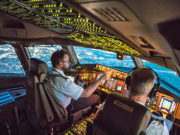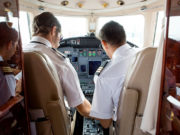
Training is a process whereby knowledge and skills are brought together to form an experience that can be stored as an almost-automated action and reaction. In the training process, motivation is crucial because a strongly motivated trainee generally progresses more quickly and smoothly.
A trainee’s motivation can be undermined throughout training by many factors, including poor performance by the student in examinations or on a check flight, lack of standardization by the instructors, lack of training continuity, poor job prospects at the completion of training, financial concerns or difficulties during training, and lack of job security, says Arunas Miezanskas, head of training at BAA Training.
Trainees can lose the motivation if they take a short-term view of the industry and think that they are the only individuals that have ever experienced motivation-dampening factors, according to Miezanskas.
“Any elder or retired pilot will verify that their career has never been short on adventure, excitement or uncertainty,” he says. “However, these elders will admit that these and many other factors may have dented their motivation and enthusiasm for a short period, but [they] never wavered … from the initial drive and determination to carve out a career as a pilot. Pilots are professionals who are self-motivated and have a professional pride in how they do their job. The initial psychological assessment for the trainees will ensure that the motivated and passionate individuals are selected.”
Motivation and Training
Crew resource management (CRM) and pedagogical training expert Thomas Fakoussa observes that the most important part in the acquisition of knowledge and skills is the perception process.
“Yet our sensory system shuts down automatically, as we all remember from school, if the subject is presented in a boring way. So, motivation is the key opener for any learning and training process,” he says. “To reinforce motivation, it is necessary for the instructor to create an atmosphere where curiosity and success are recurrently experienced. Whether one can handle a task is a useful motivation, especially for competitive characters, and so is the task itself when one can improve one’s skills. Trainers can influence this process by setting the barrier higher or lower … to make it more difficult or easier for the trainees.”
According to Agne Novikiene, competence centre director at BAA Training, a person should have strong internal motivation to become a pilot. If a person has no internal motivation, he or she should not even begin training.
“Nevertheless, we agree that motivation can be improved or reduced during the process of training,” she says. “An engaging as well as interactive style of teaching, clear links of the subject to pilots’ everyday duties and situations, willingness to give extra explanations if needed, and immediate constructive, positive and negative, feedback during training may serve as strong motivators. At the same time, for some of the students, all these things may contribute to the understanding that the pilot’s job is different from what they expected and can destroy their motivation to become a pilot.”
Indeed, it is also up to the training providers to deliver a valuable and interesting training program to keep the trainees’ motivation levels high, according to Martin Egerth, process manager of the Beyond Aviation program at Lufthansa Aviation Training.
“We have to know what is needed and expected from our trainees,” he says. “We have to prepare them for all the challenges out there, give them time and space to share experiences in the classroom and sometimes even talk about their frustration. With bad training experiences (and these could be the use of old-fashioned technology or repeating the same slides and videos over and over again) or a training that focuses only on the theory and not on practical aspects, one can destroy someone’s motivation very easily. But if one listens to the trainees, knows what they need, what their expectations are, what challenges await them … and has inspiring and empathetic trainers, one can play an integral role in the motivation of the trainees.”
Addressing Motivational Issues
Sometimes limited motivation is associated with factors that are not directly related to training, such as organizational and personal factors. Trust and identification are the base for a good relationship between a company and its employees. A lack of one or both can lead to demotivation.
“Organisational factors like excessive bureaucracy and many more or less personal interpretations of rules and regulations (nit-pickers) can demotivate and even frustrate an employee to the point of leaving a training programme,” says Fakoussa. “Another easier point to solve is the personal sympathy or antipathy of employee and manager (e.g., a simple change of manager will solve this minor motivational problem).”
According to Novikiene, the modification of the training organization and its methods, or provision of a thorough explanation of why certain techniques are applied and how they serve the training objectives, may improve trainees’ motivation. “If the reason of lower motivation is hiding in personal issues that distract the student from learning, sometimes a simple conversation can solve or soften the problem because it serves as personal support, helps to reduce stress and maybe even helps to find a possible solution,” she says.
Frustration or demotivation can also occur because of a lack of transparency or appreciation, or sometimes because a trainer or trainee is having a bad day, she says, adding that if all these factors come together, then motivation might be very low.
“In these circumstances, we need good training and even better trainers,” she says. “The latter should understand the needs and feelings of the trainees. And then it helps to give them a smile, ask how they are, ask if the trainer or the group can do something for them or maybe even asking them what they want to do in the training. …We have to be aware that people might be frustrated, [have] had bad experiences in the past or are just having a bad day,” says Egerth. “But if the motivation is low due to partying the night before or a general frustration with everything – then one has to remind them politely what their role is, why training is important and kindly ask them to focus on what is ahead of them and participate.”
Motivation and Attitude
Fakoussa believes that an employee comes with a certain level of motivation. He or she can lose motivation or improve it, depending on the individual and his or her behavior in the training environment, but no one can be trained to acquire it. “Motivation should be a subject for managers competency training. If a manager cannot handle a given level of motivation of his/her employees, then this manager should no longer manage or train his/her employees and will just destroy the remaining motivation,” he observes.
Motivation can be nurtured and developed in oneself and others, according to Egerth.
“This means it is everyone’s responsibility to motivate him- or herself,” he says. “Different things are motivating us. Nobody can be motivated 24/7. But one can try to be motivated for the time of the training as appreciation to the company and the trainer, or on board an aeroplane, as the guests expect that from a crewmember.”
Indeed, attitude is a character trait or a mindset that comes from one’s upbringing, education and personal experiences. “Trainers can improve or change their trainees’ attitude by setting them an example of airmanship attitude, Fakoussa says. “Living the correct and required attitude as a role model has much more effect than telling the trainees how they should be.”
Motivation and Performance
Motivation has a direct effect on performance in both training and the work environment.
According to Miezanskas, “performance = motivation x skills” is one way of relating performance and motivation.
“For performance to be maintained at its maximum level, it is necessary for the motivation to be high and the skill level to peak,” he says. “If the motivation is lacking in a trainee pilot, then the performance levels will drop, despite the fact that the trainee can be a very skilful pilot. The lack of motivation will reflect in the trainee’s performance. Conversely, a high motivation factor may not be enough to give an excellent performance in case of poor skill level.”
Novikiene adds, “Motivation is a force that pushes us to do something, to reach a particular goal. Very often, it also makes us do our best – know more, understand more, do things better and faster. It is remarkable that highly motivated people put much more effort and time into the process, they reach for higher results, and even when they are exhausted physically, they feel happy, satisfied and, most of the time, even more energised to go further.”
The combination of motivation and performance provides the framework for trainers and managers to get the best from their trainees and employees, according to Fakoussa, who adds that performance management schemes can help improve motivation, but any fixed scheme can only influence the statistical average of a group. “The motivational background and basis are completely different with each person and have many possible causes,” he says. “Therefore, any motivational training should be able to take all this into account, and this can only be handled by very few highly skilled trainers.”
Egerth observes that some people might be motivated and do a better job knowing that high-performance leads to success, money or a promotion.
“Some develop their motivation through the contact and feedback with others or intrinsically through other things,” he says. “And unfortunately, there are also some who cannot be motivated at all. That means they do not care and just do their job – not more, not less. In this case, it is essential to find out what the reason for that behaviour is and if the job and the environment are right for them.”
Performance management schemes cannot build a long-lasting and robust motivation.
“For instance,” says Novikiene, “let’s compare a good student and a genuinely passionate one. Most of the times, the good student works to learn the study materials. Such [a] student can even sacrifice time dedicated to hobbies and friends to pass an exam, but s/he is never among those asking extra questions during and after a class each day for years, or those always looking and digging in for extra information on the subject, or trying to understand all the tiniest details about how things work. That is precisely the way the truly motivated student would act. The knowledge and skills one gains in the process, as well as the final result, are extraordinary. Each victory only stimulates the urge to set a new goal. No performance management scheme can create such permanent behaviour and outcomes.”
Miezanskas adds, “In aviation, underperforming pilots are generally the result of some factor that has eroded their skills or motivation. Skills can be eroded if [trainees] are not getting continuity in their flying or training and the subsequent gaps have not been properly addressed with extra training or simulation. If the motivation has been affected, this can be traced to the previous mentioned factors, or it can be some external factor in the pilot’s private life that may warrant investigation.”
Motivation and Competence
Pilot competence is also affected by motivation, which generally cannot be trained, says Novikiene, adding that adults “can be taught what motivation is, how it should be demonstrated and even show it, but not feel real passion for particular activities, lifestyle, specific result. Teaching someone motivation would only give temporary results.”
With regard to competence, the relation with motivation would be “competence = motivation x (training + experience),” according to Miezanskas.
“As pilots start out in their career, they can be highly motivated and enthusiastic due to landing their chosen profession. They lack experience, but if they receive good, quality training, this can make a very competent pilot in their early stages of training,” he says. “As the pilots progress through their career, the experience builds, but the quality of the training received, or the standard of the recurrent training, is also essential. When these two factors are of a high quality and combined with high motivation, they lead to a very competent pilot.”
Image: © bigmouse108 | VectorStock
Mario Pierobon, Ph.D., is a safety management consultant.



